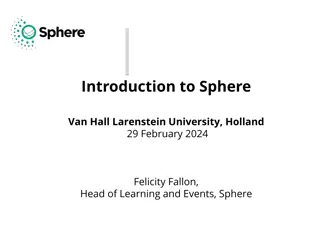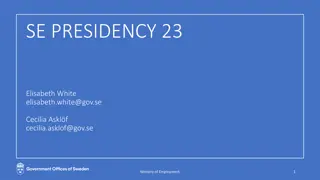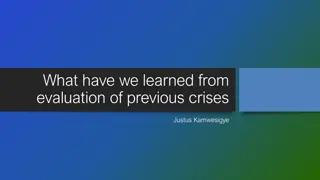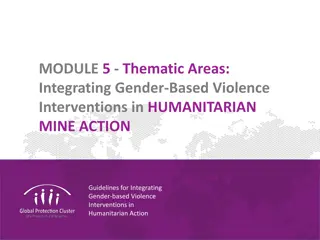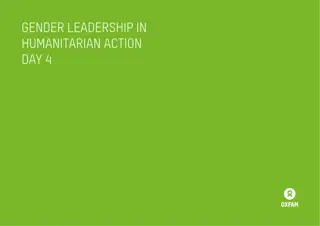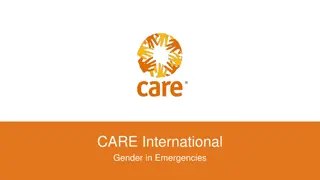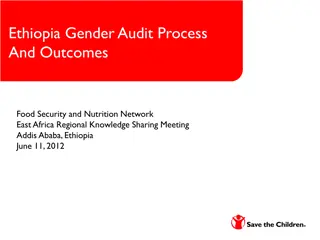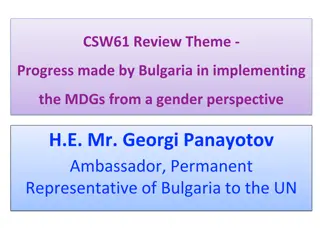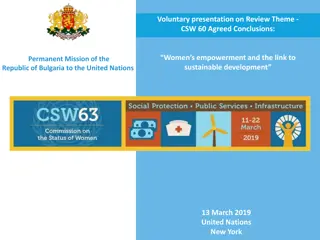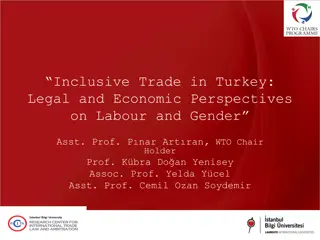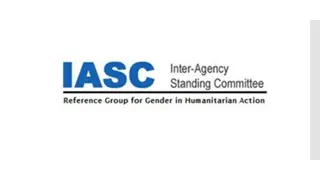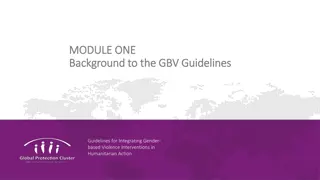Promoting Gender Equality in Humanitarian Action
Understand the importance of promoting gender equality in humanitarian action, including principles, challenges, and the need to transform attitudes and beliefs. Learn key global standards, gender analysis, and leadership in humanitarian settings. Explore the rights of women and girls, gender inequality issues, and strategies for achieving a more equal balance of power. Develop a plan for leading change on gender equality within the humanitarian community.
Download Presentation

Please find below an Image/Link to download the presentation.
The content on the website is provided AS IS for your information and personal use only. It may not be sold, licensed, or shared on other websites without obtaining consent from the author.If you encounter any issues during the download, it is possible that the publisher has removed the file from their server.
You are allowed to download the files provided on this website for personal or commercial use, subject to the condition that they are used lawfully. All files are the property of their respective owners.
The content on the website is provided AS IS for your information and personal use only. It may not be sold, licensed, or shared on other websites without obtaining consent from the author.
E N D
Presentation Transcript
Slide 1 Course objectives Understand the rationale and principles behind promoting gender equality in humanitarian action, the challenges, the fundamentalneed to change attitudes and beliefs, and the need to promote a more equal balance of power between women andmen. Participants will: know the key global standards and approaches that guide good practice on gender in humanitarian action; be confident in carrying out a gender analysis and using it to shape programming; have identified how personal beliefs about gender impact on work; understand the need to transform the attitudes and beliefs of others; understand what gender leadership in humanitarian action is, and feel inspired to promote it with confidence and authority, both within an organization and in the wider humanitarian community; have developed a plan for their own role in leading change on gender equality in humanitarian action.
Slide 2 Course content Day 1 Setting the scene: why gender equality matters in humanitarian action Day 2 Gender in humanitarian settings: the need for leadership Day3 Good practice (part I): gender analysis andstandards in humanitarianaction Day 4 Good practice (part II): participation, dignity, empowerment, protection from sexual exploitation and abuse (PSEA) and gender-based violence (GBV) Day 5 Consolidating a gender leadership model
Slide 3 Gender equality Gender equality, or equality between women andmen, refers to the equal enjoyment by females and males of all ages and regardless of sexual orientation or gender self-identification of rights, opportunities, resources and rewards. Equality does not mean that they are the same, but that their enjoyment of rights, opportunities and life chances are not governed or limited by whether they are female or male.
Slide 4 Women and girls rights Women and girls are entitled to the full and equal enjoyment of all of their human rights and to be free from all forms of discrimination this is fundamentalto achieve human rights, peace and security, and sustainable development. It includes rights to health, education, political participation, economic well-being and freedom from violence. All major international human rights instruments stipulate ending discrimination on the basis of sex. Almost all countries have ratified the Convention on the Elimination of All Forms of Discrimination against Women (CEDAW), described as the women s international bill ofrights.
Slide 5 Gender inequality Women often have less access than men to: material resources; legal recognition; public knowledge and information; decision-makingpower; economic power. They also have little control over their fertility, sexuality and marital choices.
Slide 6 Gender, power and intersectionality Gender inequality is a form of power inequality and is influenced by other factors of identity such as class, ethnicity, (dis)ability, age and sexuality. The intersection of these various identities can result in marginalization and inequality. Class Sexuality Ethnicity Age Ability
Slide 7 Transforming gendered power relations At their most basic, humanitarian programmes need to assess gender-differentiated needs, vulnerabilities and capacities and respond accordingly. But opportunities should also be taken to shift the balance of power between men and women toward greater equality. This is sometimes knows as transformative change.
Slide 8 What is a gendered stereotype? A gendered stereotype consists of beliefs about the psychological traits and characteristics of, as well as the activities appropriate to, men or women .* Gender roles are defined by behaviours, but gender stereotypes are beliefs and attitudes about masculinity and femininity. *(Source: Linda Bannon, Gender, Psychological Perspectives, Sixth Addition,2015)
Slide 9 Typical gender stereotypes Masculine Feminine Aggressive Timid Dominant Submissive Worldly/adventurous Domestic/home Independent Dependent Strong Delicate Logical Emotional Analytical Verbal
Slide 10 Leadership reflection: gender in the workplace We all share responsibility for promoting gender equality in programmes and in the workplace. We need to be aware of our own personal biases and beliefs about gender and how these affect our interactions with colleagues. Leadership needs to tackle negative gender stereotyping and discrimination, create safe spaces for discussion, and put safeguards in place.
Slide 11 The impact of disasters on women/girls and men/boys Both genders suffer during emergencies but they do so in different ways. More women than men die in natural disasters. More young men than young women die in armed conflict. Women are almost always disproportionately affected because of discrimination and their subordinate position due to their gender. Women tend to be more vulnerable to the effects of climate change and related disasters.
Slide 12 Climate change-related disasters Women are more vulnerable than men due to their multiple roles as food producers, guardians of health, caregivers and economic actors. Women depend more directly on natural resources (water, fuel, rain-fed agriculture). Women have fewer economic assets to rely on than men Violence against women rises. Female-headed households are likely to live in more precarious conditions.
Slide 13 Impact of conflict on women and men Both women and men play roles as combatants, war-makers and peace-makers. Both suffer sexual violence and rape used as a weapon of war, but women experience this disproportionately. Women s role in conflict prevention and peace- building is often over-looked. Growing awareness of gender inequality itself as a driver of conflict.
Slide 14 Resilience and social change Women are not just victims of disasters; they demonstrate enormous resilience and can be powerful agents of change, preparing for and responding to disaster. Their skills and capacities need to be harnessed within disaster management alongside those of men. Disaster often opens up opportunities for women s empowerment and the transformation of gender roles.


